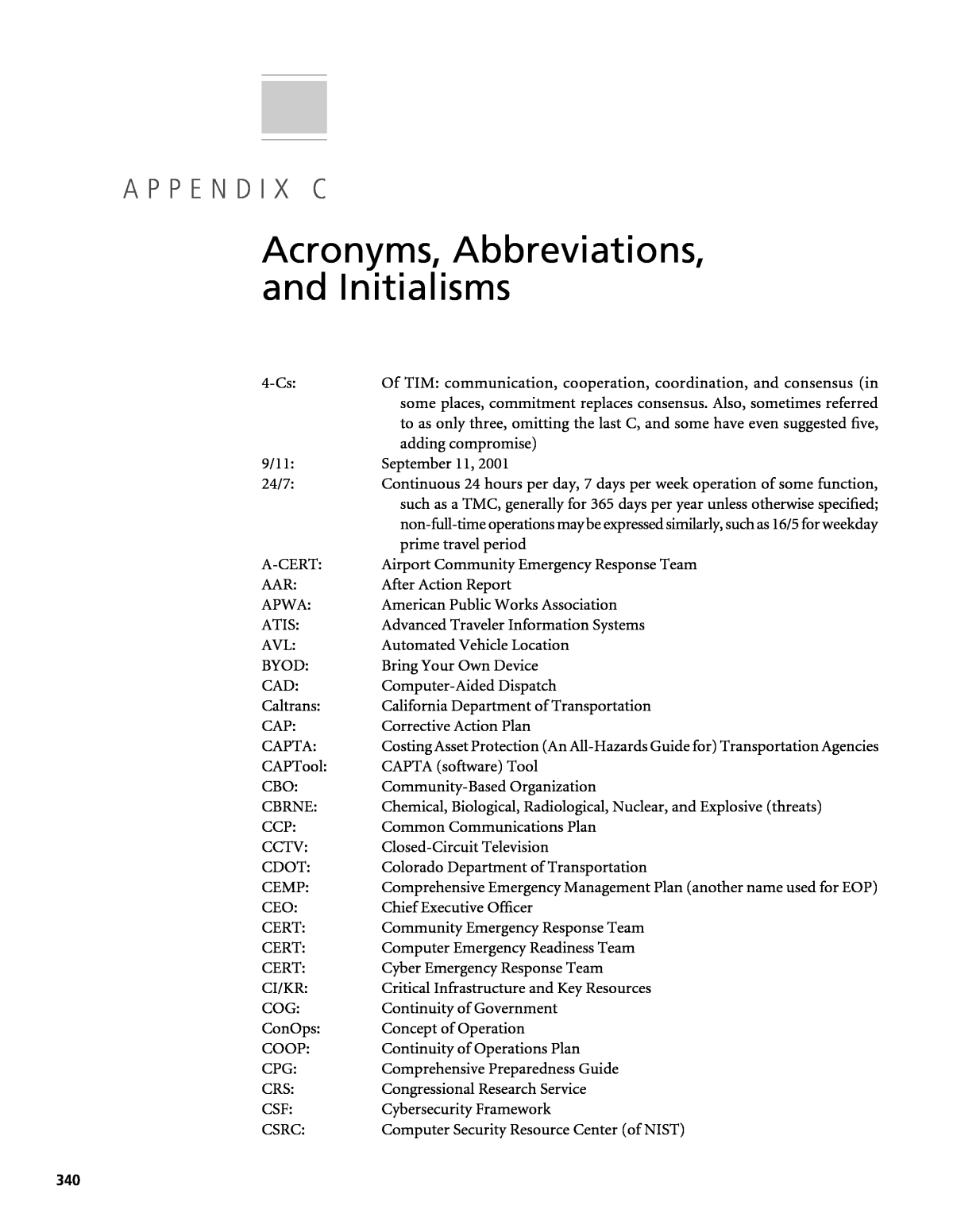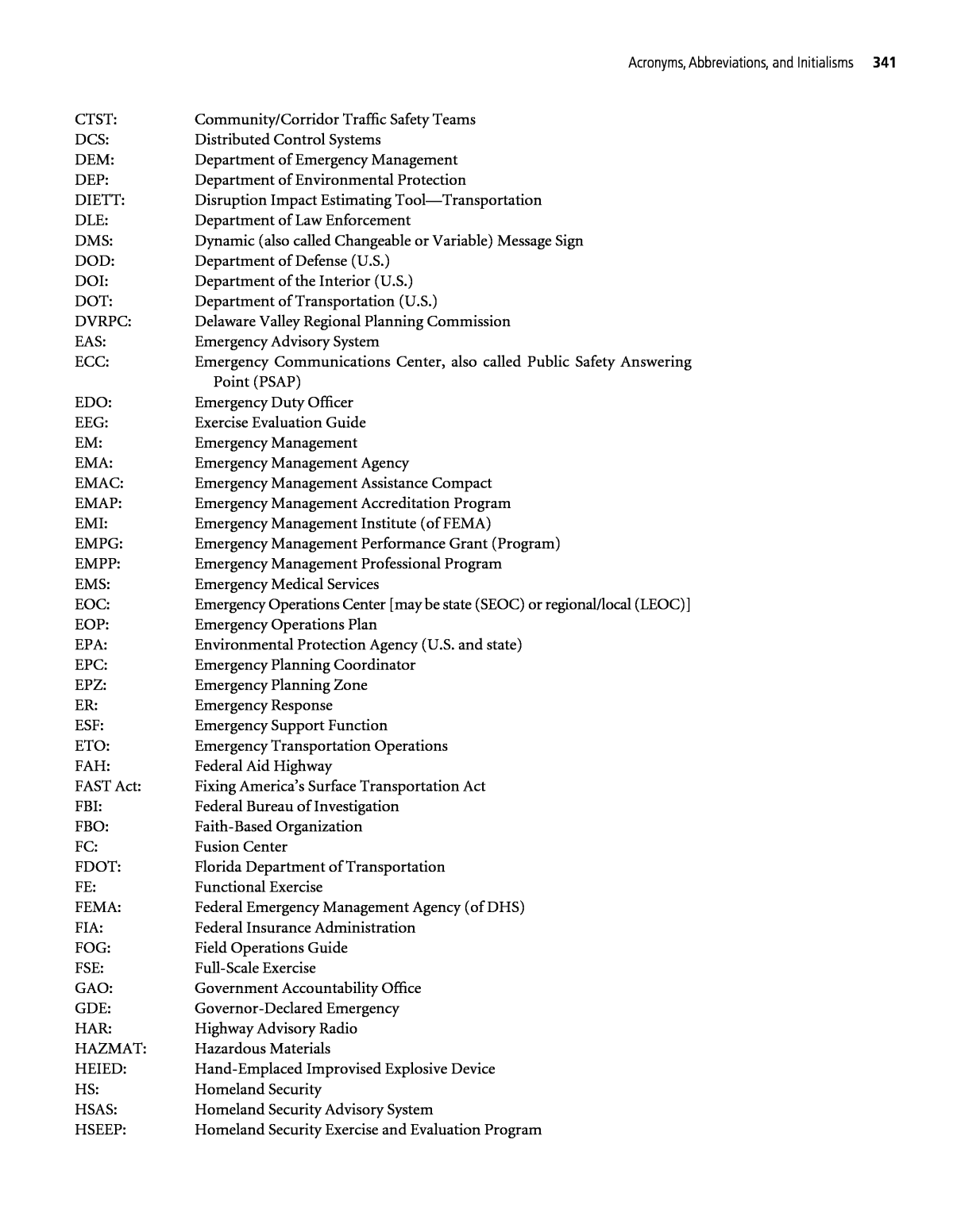




Below is the uncorrected machine-read text of this chapter, intended to provide our own search engines and external engines with highly rich, chapter-representative searchable text of each book. Because it is UNCORRECTED material, please consider the following text as a useful but insufficient proxy for the authoritative book pages.
340 4-Cs: Of TIM: communication, cooperation, coordination, and consensus (in some places, commitment replaces consensus. Also, sometimes referred to as only three, omitting the last C, and some have even suggested five, adding compromise) 9/11: September 11, 2001 24/7: Continuous 24 hours per day, 7 days per week operation of some function, such as a TMC, generally for 365 days per year unless otherwise specified; non-full-time operations may be expressed similarly, such as 16/5 for weekday prime travel period A-CERT: Airport Community Emergency Response Team AAR: After Action Report APWA: American Public Works Association ATIS: Advanced Traveler Information Systems AVL: Automated Vehicle Location BYOD: Bring Your Own Device CAD: Computer-Aided Dispatch Caltrans: California Department of Transportation CAP: Corrective Action Plan CAPTA: Costing Asset Protection (An All-Hazards Guide for) Transportation Agencies CAPTool: CAPTA (software) Tool CBO: Community-Based Organization CBRNE: Chemical, Biological, Radiological, Nuclear, and Explosive (threats) CCP: Common Communications Plan CCTV: Closed-Circuit Television CDOT: Colorado Department of Transportation CEMP: Comprehensive Emergency Management Plan (another name used for EOP) CEO: Chief Executive Officer CERT: Community Emergency Response Team CERT: Computer Emergency Readiness Team CERT: Cyber Emergency Response Team CI/KR: Critical Infrastructure and Key Resources COG: Continuity of Government ConOps: Concept of Operation COOP: Continuity of Operations Plan CPG: Comprehensive Preparedness Guide CRS: Congressional Research Service CSF: Cybersecurity Framework CSRC: Computer Security Resource Center (of NIST) A P P E N D I X C Acronyms, Abbreviations, and Initialisms
Acronyms, Abbreviations, and Initialisms 341 CTST: Community/Corridor Traffic Safety Teams DCS: Distributed Control Systems DEM: Department of Emergency Management DEP: Department of Environmental Protection DIETT: Disruption Impact Estimating ToolâTransportation DLE: Department of Law Enforcement DMS: Dynamic (also called Changeable or Variable) Message Sign DOD: Department of Defense (U.S.) DOI: Department of the Interior (U.S.) DOT: Department of Transportation (U.S.) DVRPC: Delaware Valley Regional Planning Commission EAS: Emergency Advisory System ECC: Emergency Communications Center, also called Public Safety Answering Point (PSAP) EDO: Emergency Duty Officer EEG: Exercise Evaluation Guide EM: Emergency Management EMA: Emergency Management Agency EMAC: Emergency Management Assistance Compact EMAP: Emergency Management Accreditation Program EMI: Emergency Management Institute (of FEMA) EMPG: Emergency Management Performance Grant (Program) EMPP: Emergency Management Professional Program EMS: Emergency Medical Services EOC: Emergency Operations Center [may be state (SEOC) or regional/local (LEOC)] EOP: Emergency Operations Plan EPA: Environmental Protection Agency (U.S. and state) EPC: Emergency Planning Coordinator EPZ: Emergency Planning Zone ER: Emergency Response ESF: Emergency Support Function ETO: Emergency Transportation Operations FAH: Federal Aid Highway FAST Act: Fixing Americaâs Surface Transportation Act FBI: Federal Bureau of Investigation FBO: Faith-Based Organization FC: Fusion Center FDOT: Florida Department of Transportation FE: Functional Exercise FEMA: Federal Emergency Management Agency (of DHS) FIA: Federal Insurance Administration FOG: Field Operations Guide FSE: Full-Scale Exercise GAO: Government Accountability Office GDE: Governor-Declared Emergency HAR: Highway Advisory Radio HAZMAT: Hazardous Materials HEIED: Hand-Emplaced Improvised Explosive Device HS: Homeland Security HSAS: Homeland Security Advisory System HSEEP: Homeland Security Exercise and Evaluation Program
342 A Guide to Emergency Management at State Transportation Agencies HSOC: Homeland Security Operations Center HSPD: Homeland Security Presidential Directive IAP: Incident Action Plan IC3: Internet Crime Complaint Center (I)CP: (Incident) Command Post ICS: Incident Command System ICS-CERT: Industrial Control Systems Cyber Emergency Response Team ID: Identification (card or other) IGEMS: Interior Geospatial Emergency Management System IP: Improvement Plan IRGC: International Risk Governance Council IRP: Incident Response Patrol ISAC: Information Sharing and Analysis Center I-STEP: Intermodal Security Training and Exercise Program ITS: Intelligent Transportation Systems JFO: Joint Field Office JIC: Joint Information Center JIS: Joint Information System LEOP: Local Emergency Operations Plan (county, region, etc.) LEPC: Local Emergency Planning Committee LIDAR: Light Detection and Ranging LLIS: Lessons Learned Information Sharing (DHS Website) LRFD: Load and Resistance Factor Design LTAP: Local Technical Assistance Program M&O: Management and Operations (in this context, Operations and Maintenance are both included in the âOâ here) MAC(S): Multiagency Coordination (System) (of NIMS) MAP-21: Moving Ahead for Progress in the 21st Century (Act) MBTA: Massachusetts Bay Transportation Authority MCEER: Multidisciplinary Center for Earthquake Engineering Research MOA: Memorandum of Agreement MOT: Maintenance of Traffic MOU/A: Memorandum of Understanding/Agreement MPO: Metropolitan Planning Organization MSEL: Master Scenario Events List MUTCD: Manual on Uniform Traffic Control Devices for Streets and Highways NADO: National Association of Development Organizations NAS: National Academy of Sciences NCCoE: National Cybersecurity Center of Excellence NDRF: National Disaster Recovery Framework NEMA: National Emergency Management Association NEP: National Exercise Program NFIP: National Flood Insurance Program NFPA: National Fire Protection Association NGO: Nongovernmental Organization NHI: National Highway Institute (of FHWA) NHTSA: National Highway Traffic Safety Administration NIAC: National Infrastructure Advisory Council NIC: National Integration Center (the Incident Management Systems Integration Division of FEMA) NIMS: National Incident Management System
Acronyms, Abbreviations, and Initialisms 343 NIMSCAST: NIMS Capability Assessment Support Tool NIPP: National Infrastructure Protection Plan NIST: National Institute of Standards and Technology NMF: National Mitigation Framework NOAA: National Oceanic and Atmospheric Administration NOC: National Operations Center (of the U.S. Department of Justice) NOCoE: National Operations Center of Excellence NOFO: Notice of Funding Opportunity NPG: National Preparedness Goal, or National Preparedness Guidelines NPS: National Preparedness System NPS: National Planning Scenarios NRF: National Response Framework NRP: National Response Plan (replaced by the NRF) NTAS: National Terrorism Advisory System NTIMC: National Traffic Incident Management Coalition NUG: National Unified Goal (for Traffic Incident Management) NVD: National Vulnerability Database NWS: National Weather Service NYSDOT: New York State Department of Transportation O&M: Operations and Maintenance OSHA: Occupational Safety and Health Administration OSSPAC: Oregon Seismic Safety Policy Advisory Commission PIARC: Permanent International Association of Road Congresses (World Road Association) PIO: Public Information Officer PLC: Programmable Logic Controllers PPD: Presidential Policy Directive PPE: Personal Protective Equipment PSAP: Public Safety Answering Point, also called Emergency Communication Center (ECC) PSE: Planning for Special Events, or Planned Special Events QC: Quick Clearance RRCC: Regional Response Coordinating Center S&L: State and Local (governments) SAFECOM: Safe Communications (DHS program) SARS: Severe Acute Respiratory Syndrome SCADA: Supervisory Control and Data Acquisition SCIP: Statewide Communications Interoperability Planning (DHS methodology) SCOTSEM: Special Committee on Transportation Security and Emergency Manage- ment (of AASHTO) SEMA: State Emergency Management Agency SHRP 2: Strategic Highway Research Program, second generation SMART: Specific, Measurable, Achievable, Relevant, Time-Bound SOG: Standard Operating Guidelines SOP: Standard Operating Procedure SSOM: Subcommittee on Systems Operations and Management (of AASHTO) SSP: Sector-Specific Plan, or Safety Service Patrol State EOP: State(wide) Emergency Operations Plan STIX: Southern Traffic Incident eXchange TCC: Traffic Control Center TCL: Target Capabilities List
344 A Guide to Emergency Management at State Transportation Agencies TCP: Traffic Control Point TEP: Training and Exercise Plan TEPW: Training and Exercise Planning Workshop TERA: Transportation/Transit Emergency Response Application TERET: Transportation Emergency Response Effects Tracking THIRA: Threat and Hazard Identification and Risk Assessment TIM: Traffic Incident Management TMC: Transportation (or Traffic) Management Center TOPPLEF: Training, Organizations, Plans, People, Leadership and Management, Equipment, and Facilities TRANSCOM: Transportation Operations Coordinating Committee TSGP: Transit Security Grant Program TSM&O: Transportation System Management & Operations TTAP: Tribal Technical Assistance Program TTC: Temporary Traffic Control TTX: Tabletop Exercise TWIC: Transportation Workers Identification Credential TxDOT: Texas Department of Transportation USA PATRIOT: Uniting and Strengthening America by Providing Appropriate Tools Required to Intercept and Obstruct Terrorism UC: Unified Command URL: Universal (or Uniform) Resource Locator (Website address) USACE: U.S. Army Corps of Engineers USC: U.S. Code (Public Law) US-CERT: U.S. Computer Emergency Readiness Team USCG: U.S. Coast Guard (of DHS) USFA: U.S. Fire Administration (of FEMA) USGS: U.S. Geological Service USM: U.S. Military (multiple branches) UTL: Universal Task List UVC: Uniform Vehicle Code VTrans: Vermont Agency of Transportation WMD: Weapon of Mass Destruction
